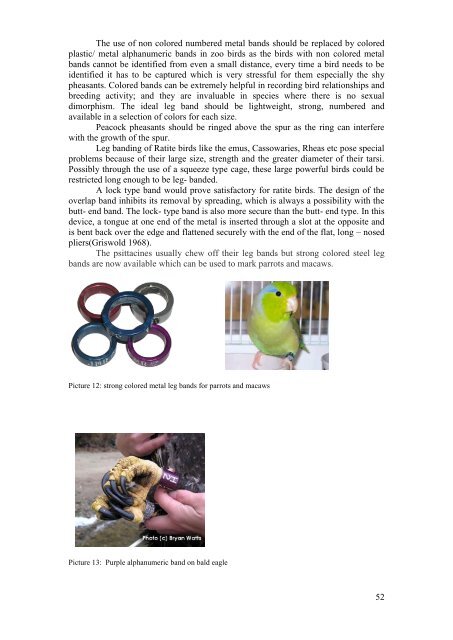standardization of records keeping in indian zoos - Central Zoo ...
standardization of records keeping in indian zoos - Central Zoo ...
standardization of records keeping in indian zoos - Central Zoo ...
You also want an ePaper? Increase the reach of your titles
YUMPU automatically turns print PDFs into web optimized ePapers that Google loves.
The use <strong>of</strong> non colored numbered metal bands should be replaced by colored<br />
plastic/ metal alphanumeric bands <strong>in</strong> zoo birds as the birds with non colored metal<br />
bands cannot be identified from even a small distance, every time a bird needs to be<br />
identified it has to be captured which is very stressful for them especially the shy<br />
pheasants. Colored bands can be extremely helpful <strong>in</strong> record<strong>in</strong>g bird relationships and<br />
breed<strong>in</strong>g activity; and they are <strong>in</strong>valuable <strong>in</strong> species where there is no sexual<br />
dimorphism. The ideal leg band should be lightweight, strong, numbered and<br />
available <strong>in</strong> a selection <strong>of</strong> colors for each size.<br />
Peacock pheasants should be r<strong>in</strong>ged above the spur as the r<strong>in</strong>g can <strong>in</strong>terfere<br />
with the growth <strong>of</strong> the spur.<br />
Leg band<strong>in</strong>g <strong>of</strong> Ratite birds like the emus, Cassowaries, Rheas etc pose special<br />
problems because <strong>of</strong> their large size, strength and the greater diameter <strong>of</strong> their tarsi.<br />
Possibly through the use <strong>of</strong> a squeeze type cage, these large powerful birds could be<br />
restricted long enough to be leg- banded.<br />
A lock type band would prove satisfactory for ratite birds. The design <strong>of</strong> the<br />
overlap band <strong>in</strong>hibits its removal by spread<strong>in</strong>g, which is always a possibility with the<br />
butt- end band. The lock- type band is also more secure than the butt- end type. In this<br />
device, a tongue at one end <strong>of</strong> the metal is <strong>in</strong>serted through a slot at the opposite and<br />
is bent back over the edge and flattened securely with the end <strong>of</strong> the flat, long – nosed<br />
pliers(Griswold 1968).<br />
The psittac<strong>in</strong>es usually chew <strong>of</strong>f their leg bands but strong colored steel leg<br />
bands are now available which can be used to mark parrots and macaws.<br />
Picture 12: strong colored metal leg bands for parrots and macaws<br />
Picture 13: Purple alphanumeric band on bald eagle<br />
52
















